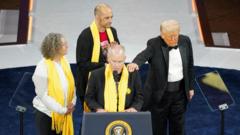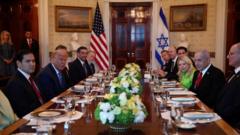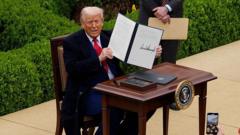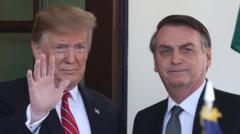President Trump has introduced a new 25% tariff targeting South Korea and Japan, effective August 1, causing market declines as investors express concern over escalating trade negotiations.
Trump's 25% Tariff on South Korea and Japan Sparks Market Reaction

Trump's 25% Tariff on South Korea and Japan Sparks Market Reaction
President Trump imposes substantial tariffs, signaling increased trade tensions with Asia.
In a significant move on July 7, 2025, President Trump announced a 25 percent tariff on exports from South Korea and Japan, set to take effect on August 1. Alongside this announcement, he revealed that the implementation of steeper tariffs on numerous other nations would be temporarily halted. The immediate reaction in the financial markets reflected investor anxiety, as stocks dropped sharply in response to the steep tariffs imposed on key trading allies.
In addition to the tariffs on South Korea and Japan, Trump disclosed plans for higher tariffs on several other countries: a staggering 40 percent for Myanmar and Laos, 30 percent for South Africa, and a 25 percent levy on Kazakhstan and Malaysia. This newfound tariff campaign underscores his administration's ongoing strategy as it attempts to negotiate trade deals worldwide.
For the last three months, the U.S. government has been engaged in trade discussions with various nations; however, as of now, only preliminary agreements have been reached with the UK and Vietnam. Negotiations with South Korea and Japan have faced delays, largely due to recent elections in both countries, and ongoing U.S. tariffs on significant exports such as automobiles and electronics.
The looming fears among South Korean and Japanese officials relate to the potential for further tariffs being imposed by the Trump administration, making them hesitant to finalize trade agreements. The precarious state of these negotiations suggests a turbulent period ahead for U.S. trade relations in the Asia-Pacific region.
In addition to the tariffs on South Korea and Japan, Trump disclosed plans for higher tariffs on several other countries: a staggering 40 percent for Myanmar and Laos, 30 percent for South Africa, and a 25 percent levy on Kazakhstan and Malaysia. This newfound tariff campaign underscores his administration's ongoing strategy as it attempts to negotiate trade deals worldwide.
For the last three months, the U.S. government has been engaged in trade discussions with various nations; however, as of now, only preliminary agreements have been reached with the UK and Vietnam. Negotiations with South Korea and Japan have faced delays, largely due to recent elections in both countries, and ongoing U.S. tariffs on significant exports such as automobiles and electronics.
The looming fears among South Korean and Japanese officials relate to the potential for further tariffs being imposed by the Trump administration, making them hesitant to finalize trade agreements. The precarious state of these negotiations suggests a turbulent period ahead for U.S. trade relations in the Asia-Pacific region.


















